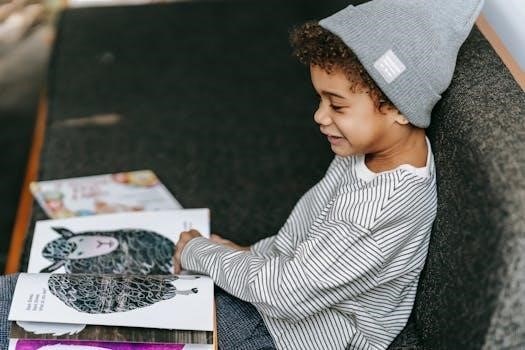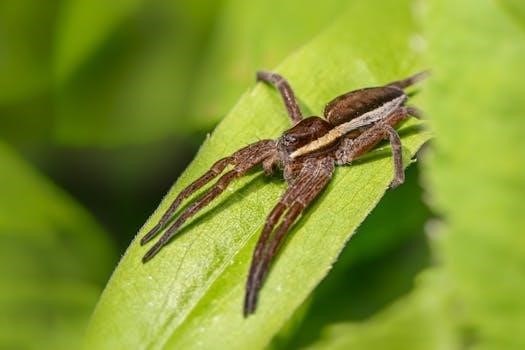The Three Little Pigs⁚ An Overview
The Three Little Pigs is a classic fairy tale loved by children for generations. The story revolves around three young pigs who leave their mother’s home to build their own houses. It imparts moral lessons about hard work‚ resilience‚ and planning.

The Three Little Pigs⁚ Building Materials and Their Significance
The pigs chose different materials⁚ straw‚ sticks‚ and bricks. These choices reflect varying degrees of effort and foresight. The straw house symbolizes speed and ease‚ the stick house is a compromise‚ and the brick house signifies strength and careful planning.
Straw House⁚ Speed and Weakness
The first little pig‚ eager to finish quickly and with minimal effort‚ opted to build his house from straw. This choice represents a desire for immediate gratification without considering long-term consequences. Straw‚ being readily available and easy to assemble‚ allowed him to construct his house rapidly. However‚ the inherent weakness of straw as a building material soon became apparent. It offered little resistance to external forces‚ making it vulnerable to the elements and‚ more importantly‚ to the big bad wolf.
The straw house symbolizes impulsivity and a lack of preparation. The pig prioritized speed over security‚ a decision that ultimately proved to be his downfall. The wolf‚ with a mere puff of breath‚ easily demolished the flimsy structure‚ highlighting the importance of choosing durable materials and investing time in building a solid foundation. The straw house serves as a cautionary tale‚ illustrating the dangers of taking shortcuts and neglecting to plan for potential challenges. It underscores the idea that quick solutions are not always the best solutions‚ especially when safety and security are at stake.
The vulnerability of the straw house emphasizes the significance of foresight and careful consideration in decision-making. The first little pig’s hasty choice not only jeopardized his own safety but also set the stage for the wolf’s initial success‚ reinforcing the narrative’s central theme of the importance of hard work and diligent planning. The swift destruction of the straw house serves as a stark reminder that taking the easy route can lead to dire consequences‚ particularly when faced with adversity.
Stick House⁚ A Compromise
The second little pig‚ learning from his brother’s mistake but still seeking a balance between speed and effort‚ chose to build his house from sticks. This decision represents a compromise between the ease of straw and the durability of bricks. Sticks‚ while requiring more effort to gather and assemble than straw‚ offered a slightly stronger and more resilient structure. The stick house symbolized an attempt at greater security‚ demonstrating a willingness to invest more time and energy compared to the first pig. However‚ it still fell short of providing adequate protection against the persistent wolf.
The stick house signifies a middle ground‚ reflecting a moderate level of planning and preparation. While the second pig acknowledged the need for a sturdier dwelling than straw‚ he did not fully commit to the arduous task of building with bricks. This compromise ultimately proved insufficient‚ as the wolf‚ with a bit more effort than before‚ was still able to huff and puff and blow the house down. The stick house illustrates the idea that half-hearted efforts often yield unsatisfactory results. It highlights the importance of fully committing to a task to achieve true success and security.
The failure of the stick house reinforces the narrative’s emphasis on the value of thorough preparation and unwavering dedication. The second little pig’s attempt to find a shortcut‚ while an improvement over the first pig’s approach‚ still resulted in vulnerability and defeat. This outcome underscores the idea that true security requires a complete commitment to building a strong foundation‚ both literally and metaphorically. The stick house serves as a reminder that compromising on quality can have detrimental consequences when faced with determined opposition.
Brick House⁚ Strength and Planning
The third little pig‚ demonstrating foresight and diligence‚ opted to build his house with bricks. This decision represents a commitment to long-term security and a willingness to invest the necessary time and effort. The brick house stands as a symbol of strength‚ stability‚ and careful planning. Unlike his brothers‚ the third pig understood the importance of a solid foundation and the need to withstand potential challenges. He patiently gathered the bricks‚ mixed the mortar‚ and meticulously constructed his house‚ ensuring its resilience against any external threats. The brick house is not just a physical structure; it embodies the values of perseverance‚ hard work‚ and strategic thinking.
The strength of the brick house lies not only in the materials used but also in the deliberate and thoughtful process of its construction. The third little pig recognized that shortcuts and compromises would ultimately lead to failure. He dedicated himself to building a house that could withstand the wolf’s relentless attacks‚ showcasing the importance of thorough preparation and unwavering determination. The brick house serves as a testament to the power of planning and the rewards of investing in quality. It highlights the idea that true security comes from building a strong foundation‚ both literally and metaphorically.
The success of the brick house reinforces the narrative’s central message⁚ that hard work‚ planning‚ and perseverance are essential for overcoming adversity. The third little pig’s foresight and dedication not only protected him from the wolf but also provided a safe haven for his brothers. The brick house becomes a symbol of hope and resilience‚ demonstrating that with careful planning and unwavering commitment‚ even the most formidable challenges can be overcome. It underscores the enduring value of investing in quality and building a strong foundation for future success.

The Wolf’s Tactics and Failures
The wolf‚ the antagonist of the story‚ employs a variety of tactics in his attempts to capture the three little pigs. Initially‚ he relies on intimidation and brute force‚ attempting to blow down the houses made of straw and sticks. His signature phrase‚ “Little pig‚ little pig‚ let me in!” followed by the threat‚ “I’ll huff‚ and I’ll puff‚ and I’ll blow your house in!” highlights his aggressive and domineering approach. These tactics prove successful against the first two pigs‚ who prioritized speed and convenience over security. However‚ the wolf’s methods are ultimately thwarted by the third pig’s sturdy brick house.
As the story progresses‚ the wolf’s tactics evolve from direct confrontation to cunning and deception. When he realizes that he cannot blow down the brick house‚ he attempts to trick the third pig by suggesting rendezvous at various locations‚ such as the market or the apple tree. However‚ the third pig outsmarts him each time‚ demonstrating his superior intelligence and preparedness. The wolf’s failure to deceive the third pig highlights the importance of critical thinking and not being easily swayed by false promises.
In a final act of desperation‚ the wolf attempts to enter the brick house through the chimney. This desperate attempt reveals his unwavering determination to capture the pigs‚ but it also leads to his ultimate downfall. The third pig‚ anticipating the wolf’s plan‚ sets a pot of boiling water in the fireplace‚ causing the wolf to fall in and meet his demise. The wolf’s failure underscores the importance of careful planning and the consequences of underestimating one’s opponent. It also serves as a cautionary tale about the dangers of greed and unchecked aggression. The wolf’s repeated failures highlight the triumph of intelligence‚ hard work‚ and perseverance over brute force and deception.

Moral Lessons and Educational Value
The Three Little Pigs is a timeless tale that offers a wealth of moral lessons and educational value for children. At its core‚ the story emphasizes the importance of hard work‚ planning‚ and perseverance. The first two pigs‚ who prioritize speed and ease in building their houses‚ suffer the consequences of their laziness when the wolf easily destroys their homes. In contrast‚ the third pig‚ who invests time and effort in building a sturdy brick house‚ is ultimately safe and successful. This highlights the value of diligence and the rewards of careful preparation. The tale also emphasizes the significance of foresight and the ability to anticipate potential challenges.
Beyond the work ethic‚ the story teaches children about the importance of intelligence and critical thinking. The third pig not only builds a strong house‚ but he also outsmarts the wolf’s attempts at deception. This underscores the importance of being wary of strangers and not easily falling for tricks or false promises. The story can also be used to teach children about different building materials and their relative strengths and weaknesses. The contrast between straw‚ sticks‚ and bricks provides a tangible lesson in structural integrity.
Furthermore‚ The Three Little Pigs can be a valuable tool for developing literacy skills. The repetitive phrases and simple plot make it easy for young children to follow along and engage with the story. The tale can also be used to encourage creative thinking and storytelling. Children can be asked to imagine alternative endings or to create their own versions of the story with different characters and settings. In conclusion‚ The Three Little Pigs is more than just a simple fairy tale; it is a rich source of moral lessons‚ educational opportunities‚ and imaginative inspiration for children of all ages. Its enduring popularity is a testament to its timeless themes and its ability to resonate with audiences across generations.

Different Versions and Adaptations
The Three Little Pigs‚ a timeless classic‚ has seen numerous adaptations and variations across different cultures and media‚ each adding its unique spin to the traditional tale. These adaptations often reflect the values‚ customs‚ and artistic styles of the societies in which they are created. In some versions‚ the characters may be animals other than pigs‚ or the wolf may be replaced by a different antagonist. The materials used for building the houses can also vary‚ depending on the available resources and local building practices.
In addition to changes in characters and settings‚ adaptations of The Three Little Pigs often explore different themes or offer alternative moral lessons. Some versions may focus on the importance of community and cooperation‚ while others may emphasize the need for ingenuity and resourcefulness. The ending of the story can also be altered‚ with some adaptations depicting the wolf being outsmarted but not harmed‚ while others may retain the more gruesome ending of the original tale.
The Three Little Pigs has also been adapted into various media formats‚ including picture books‚ animated films‚ stage plays‚ and even video games. Each medium offers a different way to experience the story‚ with visual elements‚ music‚ and interactivity adding to the overall impact. Animated versions often feature humorous characters and slapstick comedy‚ while stage adaptations may explore the themes of the story in a more theatrical and symbolic way. Regardless of the specific adaptation‚ The Three Little Pigs continues to resonate with audiences of all ages‚ demonstrating the enduring power of this classic fairy tale and its ability to be reimagined and reinterpreted for new generations. The story’s universal themes of hard work‚ perseverance‚ and overcoming adversity make it a timeless and adaptable narrative that can be enjoyed in countless ways. From traditional folktales to modern-day interpretations‚ The Three Little Pigs remains a beloved and influential story that continues to shape our understanding of morality‚ resilience‚ and the importance of planning for the future.

Be First to Comment